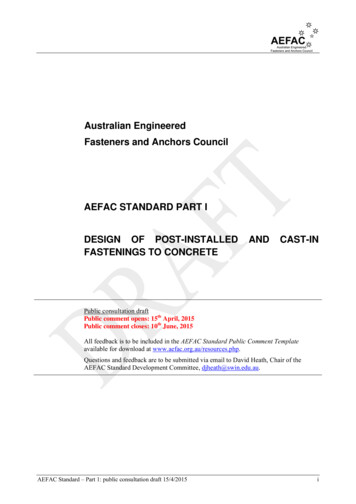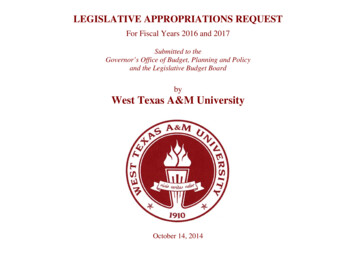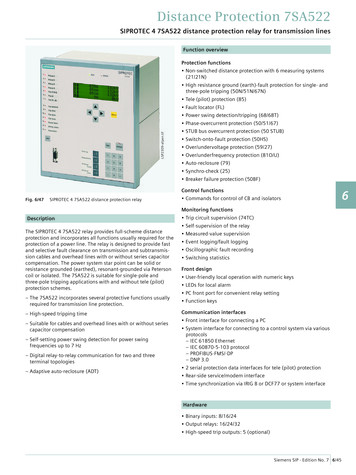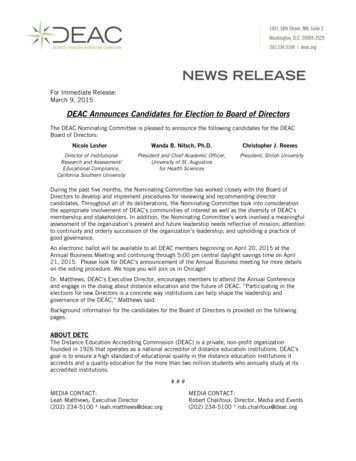
Transcription
, Edited by:Dr. Mahesh Kumar Sarva
FINANCIAL ACCOUNTINGEdited ByDr. Mahesh Kumar Sarva
Printed byEXCEL BOOKS PRIVATE LIMITEDA-45, Naraina, Phase-I,New Delhi-110028forLovely Professional UniversityPhagwara
SYLLABUSFinancial AccountingObjectives: To develop conceptual knowledge about the preparation and use of financial statements.S. No.Description1.Introduction to Accounting: Book-Keeping & its importance, Accounting- Meaning, Importance, Differencebetween Book Keeping and Accounting, Accrual Basis and Cash basis of Accounting.2.Generally Accepted Accounting Principles: Accounting Concepts and Conventions, Accounting terminology.3.Accounting Standards and Accounting Policies, Accounting Standard-1. Accounting Equation, Accounting Cycle.4.Preparation of Journal, Ledger and Balancing.5.Subsidiary Books: Cash Book and other subsidiary books. Trial Balance: Different types of errors disclosed andnot disclosed by Trial Balance.6.Financial Statements: Capital & Revenue Expenditure and Receipts, Accounting Standard-9, Profit & LossAccount (with adjustments) & Balance Sheet.7.Depreciation, Provisions and Reserves, Accounting Standard-6.8.Bank Reconciliation Statement.9.Corporate Financial Statements: Nature, types, uses and limitations.10.Role of Computers in Accounting including introduction to Tally.
CONTENTUnit 1:Introduction to Accounting1Rupesh Roshan Singh, Lovely Professional UniversityUnit 2:Principles of Accounting23Mahesh Kumar Sarva, Lovely Professional UniversityUnit 3:Accounting Standards41Rupesh Roshan Singh, Lovely Professional UniversityUnit 4:Accounting Equation and Accounting Cycle50Mahesh Kumar Sarva, Lovely Professional UniversityUnit 5:Preparation of Journal, Ledger and Balancing60Rupesh Roshan Singh, Lovely Professional UniversityUnit 6:Subsidiary Books88Mahesh Kumar Sarva, Lovely Professional UniversityUnit 7:Trial Balance115Rupesh Roshan Singh, Lovely Professional UniversityUnit 8;Financial Statements144Mahesh Kumar Sarva, Lovely Professional UniversityUnit 9:Analysis and Interpretation of Financial Statements198Rupesh Roshan Singh, Lovely Professional UniversityUnit 10:Accounting and Depreciation for Fixed Assets213Mahesh Kumar Sarva, Lovely Professional UniversityUnit 11:Bank Reconciliation Statement251Pretty Bhalla, Lovely Professional UniversityUnit 12:Corporate Financial Statements264Pretty Bhalla, Lovely Professional UniversityUnit 13:Computerised Accounting276Pretty Bhalla, Lovely Professional UniversityUnit 14:Introduction to TallyPretty Bhalla, Lovely Professional University286
Rupesh Roshan Singh, Lovely Professional UniversityUnit 1: Introduction to AccountingUnit 1: Introduction to 21.31.41.5Meaning and Definition of Accounting1.1.1Characteristics of Accounting1.1.2Objectives of Accounting1.1.3Need of Financial Accounting1.1.4Scope of Accounting1.1.5Users of Accounting Information1.1.6Importance and Advantages of Accounting1.1.7Limitation of AccountingProcess of Accounting1.2.1Cash System1.2.2Accrual mportance of Book-keeping1.3.3Difference between Book-keeping and AccountingMethods of Accounting1.4.1Single Entry1.4.2Double EntryTypes of Accounts1.5.1Personal Accounts1.5.2Real Accounts1.5.3Nominal Accounts1.6Accounting Terminology1.7Accounting Cycle1.7.1Distinction between Book-keeping and Accounting1.8Summary1.9Keywords1.10 Review Questions1.11 Further ReadingsLOVELY PROFESSIONAL UNIVERSITY1
Financial AccountingNotesObjectivesAfter studying this unit, you will be able to: Understand needs and objectives of accounting Know branches of accounting Know users and difference between book-keeping and accounting Describe meaning, importance and rules of double entry systemIntroductionAccounting is a business language which elucidates the various kinds of transactions during thegiven period of time.Accounting is broadly classified into three different functions viz. Recording Classifying and SummarizingAmerican Institute of Certified Public Accountants Association defines the term accounting asfollows “Accounting is the process of recording, classifying, summarizing in a significant mannerof transactions which are in financial character and finally results are interpreted.”The main object of a business house is to earn profit. Accounting is the medium of recording thebusiness activities and it considered as a language of business. To find out the results of abusiness, the information relating to the cost of the products and revenues from the products iscollected. Then the costs and revenues are compared to find out the profit or loss of the business.If volume of sales of the products is high and the number of transaction of the business is veryhigh, it is impossible to keep all these transactions in the mind of a business man. Thus a need ofrecording of all these business transactions rose. The recording of business transactions oractivities is done through a process of accounting. There is an old quotation of a well knownauthor of accounting Prof. R.R. Gupta, First write or record before one deliver the goods orrenders the services and if there is any disagreement in future, use the writing or record as anevidence to resolve the misunderstanding or rectifying the errors.Today the business activities are recorded not only to find out the profit or loss of the business,but are also to judge the financial position of the business. Accounts of the business are preparedfrom the point of view of owner and also serve the purpose of outsiders. Creditors and investorswant to know how safe their investment is—Labours in conducting the negotiations for wagesand government to determine the economic policies etc. Thus accounts of a business are theevidence on the basis of which the financial decisions are taken.!Caution Accounting is not an equivalent function to book keeping. Accounting is broaderin scope than the book keeping; the earlier cannot be equated to the latter.1.1 Meaning and Definition of AccountingAccounting is treated as the language of business. It records all the transactions which can bemeasured in money and have occurred in a particular period. Accounts of a business provideuseful information to its users.2LOVELY PROFESSIONAL UNIVERSITY
Unit 1: Introduction to AccountingThere are many definitions of accounting. Some of the most important definitions are givenbelow:1.As per Robert N. Anthony – “Accounting system is a means of collecting, summarizing,analyzing and reporting, in monetary terms, information about the business”.2.The American Accounting Association (AAA) has defined accounting as, “the process ofidentifying, measuring and communicating economic information to permit informaljudgments and decisions by users of information”.3.The Committee on Terminology of American Institute of Certified Public Accountantsgave a generally accepted definition of accounting – “Accounting is the art of recording,classifying and summarizing in a significant manner and in terms of money transactionsand events which are, in part at least, of a financial character, and interpreting the resultsthereof.”NotesOn the basis of above definitions we conclude that accounting is a science as well as an art ofrecording of activities of the business which can be measured in money and analyzing andinterpreting them.1.1.1 Characteristics of AccountingOn the basis of above definitions, the characteristics of accounting may be drawn as follows:1.Accounting is the art of recording of financial transactions of the business: All thosetransactions of business which are financial in nature are recorded in accounting and thosewhich are not of financial nature are not recorded in accounting. As the honesty of theworkers cannot be measured in money, it cannot be recorded into accounting.2.Classifying and summarising of recorded data is done in accounting: In accounting thefinancial transactions are recorded in the journal. With the help of journal, the recordeddata are classified into ledger under appropriate heads. Then with the help of ledger thetrial balance and financial statements are prepared.3.Data are recorded in terms of money: In accounting, the financial data are recorded in adefinite term i.e. money. No other unit is accepted to record the business transaction. Ifthere is sale of 100 articles at the rate of 50 per article, only the monetary value of thesearticles i.e. 5,000 (100 x 50) is recorded.4.Accounting is a science also: On account of recording of business transactions in a systematicmanner, it is also called a science. First the business transactions are recorded in theprimary books i.e. journal, for classification the ledger is prepared. With the help ofledger the trail balance, profit and loss account and balance sheet is prepared. Profit andloss account is prepared after a period to find the result of the business and balance sheetto know the financial position of the business.5.Analysing and interpretation of the results is done in accounting: It not only recordclassifies and summaries the business data but also analyse and interprets the results forthe future decisions. On the basis of data forecasting regarding profit, sales, etc., may bedone.1.1.2 Objectives of AccountingThe main purpose of book-keeping and accounting is to furnish the necessary financial data tothe persons interested in the business. These persons can be the internal users of the business andexternal users of the business. Among the internal users all the managers at lower, middle andtop level are included. While among the external users, investors, creditors, government andLOVELY PROFESSIONAL UNIVERSITY3
Financial AccountingNotespublic are included. The financial statements are supplied to the external users for the necessaryinformation. In brief, following are the objectives of accounting:1.To maintain the systematic records of the business: The primary objective of the accountingis to maintain the records of all transactions of the business. As the memory of humanbeing is very limited and short, it would be very difficult to remember all the transactionsespecially if there is a huge amount of transaction. So it is very necessary to record allbusiness transactions properly to determine the amount of profit or loss and the financialposition of the business on a particular date.2.To ascertain the profit or loss of the business: The main objective of the business is to earna profit. Exact profit can be ascertained with the help of financial accounting which helpsto determine the net profit or loss of the business over a period. For the determination ofthe amount of profit or loss, a trading and profit and loss account is prepared at the end ofa period. If there is excess of revenue for a period over the expenses incurred to earn thatrevenue, it is said to be a profit. And if there is excess of expenses over the revenue, it issaid to be a loss. In the case of profit the management can take the decisions relating toselling price and output etc. In the case of loss, the causes of such a loss are investigated andremedial action is taken by the management.3.To present the financial position of the business: The objective of the accounting is notonly recording of the financial transactions of the business and determination of profit orloss but also to present the financial position of the business. To present the financialposition, financial accounting helps in the preparation of balance sheet. Balance sheet isthe statement of assets and liabilities of the business. It also gives the information aboutthe borrowed capital as well as owned capital along with different assets such as fixedassets, current assets and miscellaneous. Balance sheet is the reflector of the financialposition of a business (solvency and insolvency).4.To provide the financial information to the various users: One more objective of theaccounting is to provide the required financial information to the different users - internalas well as external users. Internal users of the financial statements are owners, shareholders,management and external users of the financial statements are debenture holders, creditors,investors, employees, government, etc.5.For Decision Making: These days accounting has taken upon itself the task of collection,analysis and reporting of information at the required points of time to the required levelsof authority in order to facilitate rational decision-making.1.1.3 Need of Financial AccountingA well known author of Accounting, [Prof. R.R. Gupta, Principal, Poddar College, Nawalgarh(Rajasthan)] wrote in .”First write/record before one delivers goods or renders the servicesand if there is any disagreement in future, use the writing or record as an evidence to resolve themisunderstanding or rectifying the error.”Recording of business transactions is necessary from owners’ point of view and other interestedparty as well. The persons included in the second category are the suppliers of the materials,products and services to the business, the government and the society at large. The creditors(suppliers who are willing to take their payment later) are interested to know whether the businesswill be able to pay them later (solvency of the business) whereas the government wants to knowwhether the business has paid whatever was due to them in terms of taxes, fees, etc.Did u know? What are the purposes of preparing financial statements?1.4Accounting provides necessary information for decisions to be taken initially and itfacilitates the enterprise to pave way for the implementation of actions.LOVELY PROFESSIONAL UNIVERSITY
Unit 1: Introduction to Accounting2.It exhibits the financial track path and the position of the organization.3.Being business in the dynamic environment, it is required to face the ever changingenvironment. In order to meet the needs of the ever changing environment, thepolicies are to be formulated for the smooth conduct of the business.4.It equips the management to discharge the obligations at every moment.5.Obligations to customers, investors, employees, to renovate/restructure and so on.Notes1.1.4 Scope of AccountingThe Scope of accounting is divided into following two parts:1.Branches of Accounting2.Accounting as a science or an artBranches of AccountingThe main objectives of accounting are to record the business transactions and to provide thenecessary information to the internal and external users of the financial statements. In order toachieve the above objectives, the accounting is classified into followings branches:1.Financial Accounting: It is the original form of accounting. It refers to the recording ofdaily business financial transaction. Recording of the transaction is done in such a waythat the profit of the business may be ascertained after a definite period and the picture ofthe financial position of the business may be presented.2.Cost Accounting: As the name indicates, this accounting is related with the ascertainmentof cost of the product in a period. Under this system, record of raw materials used inproduction, wages and labour paid and other expenses incurred on production are kept tocontrol the costs.3.Management Accounting: The accounting which provides the necessary information tothe management is called management accounting. Under this, the analysis andinterpretation of the accounts, prepared by financial accounting, are done in a manner sothat the managers may forecast, plan for future and frame the policy.4.Tax Accounting: Under tax accounting, the accountants prepare the accounts as per theprovisions of taxation. The accounts prepared as per taxation provisions may differ fromthe accounts prepared as per financial accounting.5.Inflation Accounting: The financial statements are prepared on the basis of historical costwhich do not present the true picture of the financial position and correct profit or loss ofthe business due to inflation. Thus the fresh financial statements are prepared keeping inmind the price level changes under inflation accounting.6.Human Resource Accounting: Human Resource Accounting means the accounting forhuman being as now in an organization human being is treated as an asset like otherphysical assets. It is recorded in the books like other assets. HRA deals with themeasurement of costs on recruiting, selecting, hiring, training, placing and developmentof the employees in one side and on the other side it deals with the present economic valueof the employees. For the determination of the value of human being different methodsare used under HRA.7.Responsibility Accounting: Responsibility accounting is a special technique of managementunder which accountability is established according to the responsibility delegated to theLOVELY PROFESSIONAL UNIVERSITY5
Financial AccountingNotesvarious levels of management. Management information and reporting system is institutedto give adequate feedback in terms of the delegated responsibility. Under this system,units of an organization, under a specified authority in a person, are developed asresponsibility center and evaluated individually for their performance.Accounting as Science or an ArtAccounting is both the science and art. Study of science is based on some principles and it issystemized. It is a science because the business transactions are recorded on the basis of someprinciples and journal of transaction, ledger posting, trial balance and preparation of finalstatements are done in a sequence. Art is the creation of practical applications and rules for thecompletion of any work. On the basis of it, accounting is an art as we do not only study principlesof accounting but also we learn to apply these principles in practice to record the businesstransaction. Thus accounting is both science and art.1.1.5 Users of Accounting InformationThere are two types of persons interested in financial statements: (1) Internal users, and(2) External users.1.2.6Internal Users: These are: (a) Shareholders, (b) Management, and (c) Trade unionsemployees, etc.(a)Shareholders are interested to know the welfare of the business. They can know theoperational results through such financial statements and the financial position ofthe business.(b)Management is interested to take important decisions relating to fixing up the sellingprices and making future policies.(c)Trade unions and employees are interested to know the operational results becausetheir bonus etc. is dependent on the profit earned by the business. Financial statementsalso help in their negotiations for wages/salaries.External Users: The following are most important external users of financial statements:(a)Investors: They are interested to know the earning capacity of business which can beknown through financial statements. They can also know the financial soundness ofthe business through financial statements.(b)Creditors, Lenders of Money etc.: The creditors and lenders of money etc. can alsoknow the financial soundness through financial statement. They have to see twothings (i) Regularity of income and (ii) solvency of the business so that theirinvestment is risk free.(c)Government: Government is interested to formulate laws to regulate businessactivities and also law relating to taxation etc. Financial statements help whilecomputing National Income statistics etc.(d)Taxation authorities: Financial statements provide information relating to operationalresults as well as financial position of the business. Tax authorities decide the amountof tax as per financial statement. It is very useful to other taxation authorities such assales tax etc.(e)Stock Exchanges are meant for dealing in share/securities. Purchase and sale of suchshares and securities are possible through stock exchanges which provide financialinformation about each company which is listed with them.LOVELY PROFESSIONAL UNIVERSITY
Unit 1: Introduction to Accounting(f)Consumer: Consumer is interested in information on the continued existence of thebusiness and thus probability of the continued supply of the products, parts andafter sale services. They ensure continuous existence of a business, especially in caseof durable products which require after sales service and spare parts.Notes1.1.6 Importance and Advantages of AccountingAppropriate and adequate accounting system plays a vital role for the successful operation ofthe business. It also helps in the determination of cost of production, controlling internal as wellas external activities of the business, forecasting of profit, cost and sales, etc. Accounting is alsouseful in locating the errors, distribution of dividend and bonus to shareholders. Thus, accountingis being used as a means to achieve the objective of the business. The other advantages of theaccounting are as follows:1.Replacement of human memory: As the human’s memory is limited and short, it is difficultto remember all the transactions of the business. Therefore, all the financial transactionsof the business are recorded in the books. By this way the businessmen cannot only see therecords at the required time but can also remember them for a long time. Thus, recordingof the transactions is the replacement of human’s memory.2.Helpful in the determination of financial results and presentation of financial position:Accounting is very useful in the determination of the profit and loss of a business andshowing the financial position of the business.3.Helpful in assessing the tax liability: Generally, a businessman has to pay corporate tax,VAT and excise duty, etc. Therefore, it is necessary that proper accounts should bemaintained to compute the tax liability of the business.4.Helpful in the case of insolvency: Sometimes the businessman becomes the insolvent. If hehas properly maintained the accounts, he will not face the problems in explaining fewthings in the court.5.Helpful in the valuation of business: If the business is shut down and sold, accountinghelps the businessman to determine the value of business. It would be possible only inthat case when the accounts of the business are properly maintained.6.Helpful in the valuation of goodwill and shares: If accounts of the business are properlymaintained, it would be quite convenient to determine the value of goodwill. Goodwill isvery important for the determination of the value of shares of the company.7.Accounting makes comparative statement possible: Proper and adequate accounting helpsin comparing the income, expenditure, purchase, sale of the current year with that of theprevious years. And then future plans, policies and forecasting may be possible.8.Raising of funds become easy: It helps in raising funds from investors or financialinstitutions by promising investors a fixed claim (interest payments) on the cash flowsgenerated by the assets, with a limited or no role in the day-to-day running of the business.1.1.7 Limitation of AccountingIn spite of being so many uses and advantages of accounting, it has a number of limitationswhich are as follows:1.Recording of monetary items only: In accounting only those transactions, which have themonetary value, are recorded. And those transactions which do not have the financialvalue whether those are important in business, are not recorded in the accounting. Forexample, efficiency of the management, honesty of the workers, etc.LOVELY PROFESSIONAL UNIVERSITY7
Financial AccountingNotes2.Effect of inflation: In accounting the transactions are recorded at the historical cost.Accordingly the assets of the business are shown at cost in the balance sheet. Thus thebalance sheet prepared on the basis of historical cost ignores the price-level changes(inflation). In this way the balance sheet of the business does not present the true and fairpicture of the business.3.Conflict between accounting principles: In accounting, one accounting principle conflictsanother. For instance, inventory should be valued on the basis of ‘least of the cost andmarket price’ as per the principle of the conservatism. If in the first year, inventory isvalued on the basis of cost (being lower than market price) and in the second year at themarket price (being lower than cost), this principle conflicts the accounting principle ofthe consistency.4.Financial statements are affected by personal judgment of the accountants: Personaldecisions of the accountants regarding the adoption of accounting policies, affects theresults of the financial statements. As a result the financial statements lose their objectivity.5.Financial statements do not reflect the right picture of the business: Sometimes the profitand loss account of the business does not show the accurate profit/loss and the balancesheet does not show the true picture of the business because the assets shown in thebalance sheet are shown at the realizable (resalable) value which is wrong. Some worthlessfigures are also shown in the balance sheet as preliminary expenses, discount on issue ofshares/debentures, etc.Self AssessmentFill in the blanks:1. is the process of recording, classifying, summarizing in a significantmanner of transactions which are in financial character and finally results are interpreted.2.The users of accounting are and external.3.Accounting records all the transactions which can be expressed either in .4.The creditors are interested to know the of the business.5.The primary objective of the accounting is to maintain the records of all of the business.1.2 Process of AccountingAccounting is described as origin for the creation of information and the continuous utility ofinformation. Now the question is how is this information created? For this, there is a step bystep process, as shown in Figure 1.1.After the creation of information, the developed information should be appropriately recorded.Are there any scales/guides available for the recording of information? If yes, what are they?They are as follows:81.What to record: Financial Transaction is only to be recorded2.When to record: Time relevance of the transaction at the moment of recording3.How to record: Methodology of recording—It contains two different systems of accountingviz. cash system and accrual system.LOVELY PROFESSIONAL UNIVERSITY
Unit 1: Introduction to AccountingNotesFigure 1.1: Process of AccountingStep 1Identification of TransactionRecordingStep 2Preparation of Business TransactionsStep 3Recording of Transactions in JournalGroupingSummarizingStep 4Posting in LedgersStep 5Preparation of Unadjusted Trial BalanceStep 6Pass of Adjustment EntriesPreparationStep 7Preparation of Adjusted Trial BalanceTrading and P&L A/cBalance Sheet1.2.1 Cash SystemThe revenues are recognized only at the moment of realization but the expenses are recognizedat the moment of payment. For example, sale of goods will be considered under this methodthat only at the moment of receipt of cash out of sale of goods. The charges which were paid onlywill be taken into consideration but the outstanding, not yet paid will not be considered.Example: Rent paid only will be considered but not the outstanding of rent charges.1.2.2 Accrual SystemThe revenues are recognized only at the time of occurrence and expenses are recognized only atthe moment of incurring. Whether the cash is received or not out of the sales, that will beregistered/counted as total value of the sales.The next most important step is to record the transactions. For recording, the value of thetransaction is inevitable, to record values; the classification of values must be essentially done.LOVELY PROFESSIONAL UNIVERSITY9
Financial AccountingNotes1.2.3 ValuesThere are four different values in the business practices that should be followed or recorded inthe system of accounting:1.Original Value: It is the value of the asset only at the moment of purchase or acquisition.2.Book Value: It is the value of the asset maintained in the books of the account. The bookvalue of the asset could be computed as follows:Book Value Gross (Original) value of the asset – Accumulated depreciation3.Realizable Value: Value at which the assets are realized.4.Present Value: Market value of the asset.Did u know? What are the purposes of preparing financial statements?1.Accounting provides necessary information for decisions to be taken initially and itfacilitates the enterprise to pave way for the implementation of actions.2.It exhibits the financial track path and the position of the organization.3.Being business in the dynamic environment, it is required to face the ever changingenvironment. In order to meet the needs of the ever changing environment, thepolicies are to be formulated for the smooth conduct of the business.4.It equips the management to discharge the obligations at every moment.5.Obligations to customers, investors, employees, to renovate/restructure and so on.Self AssessmentFill in the blanks:6.The are recognized only at the moment of realization but the are recognized at the moment of payment.7.For , the value of the transaction is inevitable, to record values; theclassification of values must be essentially done.8. the value of the asset only at the moment of purchase or acquisition.1.3 Book-keepingBook-keeping includes recording of journal, posting in ledgers and balancing of accounts. All therecords before the preparation of trail balance are the whole subject matter of book-keeping. Thus,book-keeping many is defined as the science and art of recording transactions in money or money’sworth so accurately and systematically, in a certain set of books, regularly that the true state ofbusinessman’s affairs can be correctly ascertained. Here it is important to note that only thosetransactions related to business are recorded which can be expressed in terms of money.1.3.1 Definition“Book-keeping is the art of recording business transacti
2. Generally Accepted Accounting Principles: Accounting Concepts and Conventions, Accounting terminology. 3. Accounting Standards and Accounting Policies, Accounting Standard-1. Accounting Equation, Accounting Cycle. 4. Preparation of Journal, Ledger and Balancing. 5. Subsidiary Books










